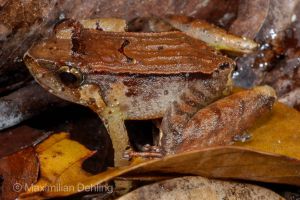
Frogs of Borneo

Frogs of Borneo

Frogs of Borneo

Frogs of Borneo

Frogs of Borneo

Frogs of Borneo

Frogs of Borneo

Frogs of Borneo

Frogs of Borneo

Frogs of Borneo

Frogs of Borneo
Bornean Families
Limnonectes:
- abanghamidi
- asperatus
- barioensis
- batulawensis
- cintalubang
- conspicillatus
- finchi
- gunungensis
- gyrinophorus
- hikidai
- ibanorum
- ingeri
- kenepaiensis
- kinabaluensis
- kong
- lambirensis
- lanjakensis
- leporinus
- maanyanorum
- malesianus
- meratusensis
- mocquardi
- nephophilus
- nusantara
- oreibates
- paginatanensis
- paramacrodon
- paulyambuni
- penerisanensis
- rhacodus
- sarawakensis
- separatus
- sinuatodorsalis
- suboliferus
- tawauensis
phylax
Smooth Guardian Frog
Limnonectes phylax inhabits lowland rainforests at elevations up to 830 meters above sea level in eastern Sarawak (Gunung Mulu National Park, Merarap) and Sabah (Danum Valley, Tawau Hills National Park, Sepilok Forest Reserve), as well as Ulu Temburong National Park (Brunei Darussalam). The type locality is Danum Valley, Rhino Pool. L. finchi can be found together with L. phylax in Sabah lowlands. It lives parapatrically with L. sarawakensis in the lowlands of Gunung
Mulu National Park, Sarawak, where it seems to prefer dipterocarp and karst forests, whereas L. sarawakensis prefers alluvial forest. At Tawau Hills, Sabah, it can be found together with L. kinabaluensis, however with the latter species populating higher elevations.
Limnonectes phylax is easily identified as a Guardian Frog of the palavanenesis-species group by its size (approx. 26-29 mm snout vent length in males, 30-35 in females), low and inconspicuous odontoid processes on the lower jaw in both sexes, a finely shagreened dorsal surface, and prominent longitudinal dorsolateral glandular ridges. The interorbital distance is equal to or greater than the width of the upper eyelid. The toes are not fully webbed, and a distinctive horseshoe-shaped dermal ridge is present in the center of the dorsum, just behind the point of forelimb insertion.
This species is distinguished from all other members of the species group by a combination of features: It has moderately extensive toe webbing; a strongly curved supratympanic fold; and a pineal spot that is barely visible. The vomerine ridges are long and narrowly spaced, while the postpalpebral ridge is well developed, extending from the upper eyelid to the front of the pelvic region. A low median ridge runs from the tip of the snout to the horseshoe-shaped dorsal ridge and becomes more pronounced between the horseshoe-shaped ridge and the vent. The lumbar ridge is also well developed.
The advertisement call is a long, rising trill consisting of 21 to 39 notes, lasting up to ca. 2 seconds.
Goyes Vallejos, who has studied the species in the field, states: "Males produce advertisement calls from the leaf litter to attract females. After mating, the females deposit a small clutch of relatively large eggs (10–20 eggs, each measuring about 2.6 mm) on the forest floor. The male guards the egg clutch for 9 to 11 days after fertilization. Upon hatching, the tadpoles climb onto the dorsum of the male, who subsequently carries them to a small body of water. The exact mechanisms by which males locate these tadpole deposition sites, as well as the distances they travel to find them, remain unknown. After depositing the tadpoles, the male leaves, and the tadpoles develop independently." According to current knowledge this also seems to apply to the other members of the palavanensis-species group.
Version tracking
-
26.06.2025
information added
